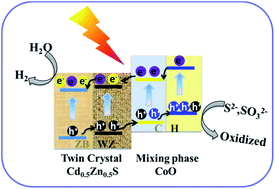A homojunction–heterojunction–homojunction scaffold boosts photocatalytic H2 evolution over Cd0.5Zn0.5S/CoO hybrids†
Abstract
We prepared a novel heterojunction containing nanocomposite (CZS/M-CoO) based on twin crystal Cd0.5Zn0.5S (CZS) and mixed-phase CoO (M-CoO) by a hydrothermal method. The high resolution transmission electron microscopy (HRTEM) examination, steady state fluorescence spectra, and time resolved fluorescence spectra revealed the formation of heterojunctions between CZS and CoO, homojunctions between zinc blende (ZB) and wurtzite (WZ) CZS, and homojunctions between cubic CoO (C-CoO) and hexagonal CoO (H-CoO) in this nanocomposite. The practical application of this composite as a photocatalyst for H2 production from water reveals that the optimized hybrid nanocomposite (per 10 mg) with 1.5% M-CoO presents the best catalytic activity with a H2 production rate of 1.78 mmol h−1, which is nearly ca. 6-fold higher than that of pristine twin crystal CZS (0.30 mmol h−1), corresponding to an apparent quantum efficiency of 37.1% at 420 nm. The nanocomposite does not show a distinctive drop in the H2 production rate after 40 h photocatalytic reaction, indicating the excellent stability of this photocatalyst. Moreover, the H2 production rate of CZS/M-CoO is much higher than that of either CZS/C-CoO or CZS/H-CoO under visible light illumination, which indicates that the homojunctions between cubic CoO and hexagonal CoO within M-CoO can enhance the separation of photogenerated electron–hole pairs. Therefore, the excellent catalytic activity of CZS/M-CoO should be attributed to the synergistic effect of heterojunctions between CoO and CZS, homojunctions in twin crystal CZS, and homojunctions in CoO, which promote remarkably the separation of photogenerated electron–hole pairs. Furthermore, M-CoO also acts as a much better co-catalyst than either pure phase H-CoO or C-CoO for photocatalytic H2 production based on other catalysts, such as g-C3N4, CdS, ZnS or TiO2. These results suggest that using a homojunction containing co-catalyst is a versatile method to promote the photocatalytic activity of a photocatalyst. We believe that this work provides a new universal approach toward more efficient photocatalysts.



 Please wait while we load your content...
Please wait while we load your content...